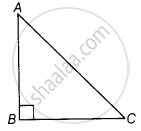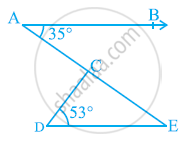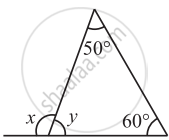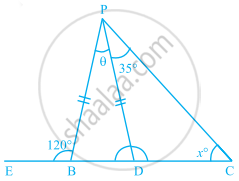Advertisements
Advertisements
Question
In a triangle, one angle is of 90°. Then ______.
- The other two angles are of 45° each
- In remaining two angles, one angle is 90° and other is 45°
- Remaining two angles are complementary
In the given option(s) which is true?
Options
(i) only
(ii) only
(iii) only
(i) and (ii)
Solution
(iii) only
Explanation:
In a right-angled ΔABC
∠B = 90°

As we know,
∠A + ∠B + ∠C = 180° ......[Angle sum property of a triangle]
⇒ ∠A + 90° + ∠C = 180°
⇒ ∠A + ∠C = 180° – 90° = 90°
Hence, the remaining two angles are complementary.
APPEARS IN
RELATED QUESTIONS
In the given figure, if AB || DE, ∠BAC = 35º and ∠CDE = 53º, find ∠DCE.

Find the value of the unknowns x and y in the following diagram:

If one angle of a triangle is equal to the sum of the other two angles, then the triangle is ______.
Prove that a triangle must have atleast two acute angles.
In a right-angled triangle, the angles other than the right angle are ______.
In the given figure, PB = PD. The value of x is ______.

If one of the angles of a triangle is 110°, then the angle between the bisectors of the other two angles is ______.
If two angles of a triangle are equal, the third angle is also equal to each of the other two angles.
The angles of a triangle are in the ratio 2:3:5. Find the angles.
The angles of a triangle are arranged in descending order of their magnitudes. If the difference between two consecutive angles is 10°, find the three angles.
